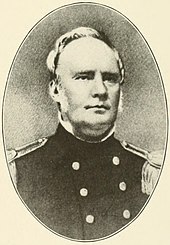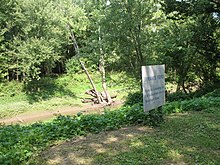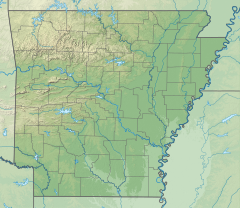13th Missouri Cavalry Regiment (Confederate)
| 13th Missouri Cavalry Regiment Wood's Missouri Cavalry Battalion 14th Missouri Cavalry Battalion | |
|---|---|
| Active | April 6, 1863 to June 8, 1865 |
| Allegiance | |
| Branch | |
| Type | Cavalry |
| Engagements | American Civil War
|
The 13th Missouri Cavalry Regiment was a
Wood's battalion fought at the
Background and formation

At the outset of the
Owing to a shortage of weapons controlled by the
Confederate cavalry in the Trans-Mississippi had an easier time procuring horses. In 1860, the states of Missouri, Arkansas,
During the American Civil War, cavalry was most commonly used to perform
Formation
On April 1, 1863, Price was sent to Little Rock, Arkansas to command a division. Five days later, Price's aide-de-camp, Captain Robert C. Wood, and 16 men of the general's escort were transferred to form a new artillery unit. By May 9, the unit had grown to 26 men manning four Williams guns and was under the authority of Brigadier General John S. Marmaduke.[18] The Williams guns were powered by hand cranks, and fired 1 pound (0.45 kg) projectiles at a rate of 18 or 20 per minute. They are sometimes considered to be early machine guns.[19] Wood was authorized to recruit cavalrymen by the Confederate District of Arkansas on June 12. According to Union estimates made in August in Fulton County, Arkansas, Wood had collected about 150 men and still had the four cannons, which were described by the Unionists as "flying artillery".[18] The Williams guns were most likely manned by men in Captain William Woodson's company of the formation. No evidence exists that suggests the pieces were ever used in battle.[20]
Service history
Pine Bluff and Poison Spring
On September 28, Wood and the 275 men he had recruited by then were ordered to move from their camp at Arkadelphia, Arkansas, to join Marmaduke's command. This order was rescinded because the unit, which was organized into a six-company battalion, was considered by Wood to be too poorly disciplined to be an effective combat unit.[18] Earlier that month, Union forces commanded by Major General Frederick Steele had taken Little Rock; this success was followed by the occupation of several points along the Arkansas River. One of these outposts was at Pine Bluff, which was defended by 550 Union cavalrymen and 300 freed slaves commanded by Colonel Powell Clayton. Marmaduke decided to lead an attack against the post, which occurred on October 25.[21] Wood's battalion took part in this action, which was known as the Battle of Pine Bluff.[18] The Confederate force was advancing from the east, and Marmaduke drew up a plan of attack that involved dividing his force. Wood's battalion was part of the detached force, which used side roads to attack from the southeast.[22]
The detached force followed this path of approach, and Wood's battalion and most of the rest of the column dismounted after reaching a
A strength report issued in October 1863 stated that the battalion had a strength of 219 men and 222 horses.[26] At some point after November 1, Wood's battalion was augmented by two companies that had been recruited by James T. Cearnal during Shelby's Raid. The unit issued a strength report on November 10, which stated that it consisted of 400 men in 8 companies. The report did not mention any artillery component; what happened to the four cannons previously associated with it is not known.[27] Documents dated as late as October 27 refer to the artillery component, those from November 3 and later do not. The Williams guns may have been sent to a different unit in November.[20] Throughout the rest of 1863, Wood's battalion served as an independent unit under Marmaduke's command; it spent the early portion of the next year associated with Price's headquarters.[27]
In March 1864, Steele was sent from Little Rock with 8,500 men to thrust into southwestern Arkansas in support of the Union
In Louisiana, the Red River campaign had been repulsed, enabling the Confederates to focus on Steele. Isolated and running low on food, the Union troops abandoned Camden on April 26, and were harried by pursuing Confederates during their retreat.[34] The 14th Missouri Cavalry Battalion participated in skirmishing during the pursuit.[29] When Steele's column reached the crossing of the Saline River, they were caught by the Confederate pursuers, who launched several futile attacks on April 30, in the Battle of Jenkins' Ferry. The Union soldiers were able to escape across a pontoon bridge and eventually reached Little Rock.[35] The 14th Missouri Cavalry Battalion had been held out of the Jenkins' Ferry fighting as a reserve unit. It then spent mid-1864 defending an outpost at Princeton, Arkansas.[29]
Price's Raid
St. Louis and Jefferson City

In the
After entering the state, Price learned of a Union force holding
Wood's battalion and the
Movement west
As the Confederates moved west, they began to meet more Union resistance. Union Major General James G. Blunt fought a delaying action in the Second Battle of Lexington on October 19, but his force was brushed aside.[49] Clark's brigade saw some action during the fighting at Lexington.[52] Blunt's retreating men left a rear guard to hold the crossing of the Little Blue River. The Confederates attacked this holding force on October 21, bringing on the Battle of Little Blue River.[53] Elements of Clark's brigade had crossed the river and were fighting against the rear guard when Blunt arrived on the field with reinforcements, pressuring the Confederates.[54] Wood's battalion crossed the river, dismounted, and took up a position in an orchard to support the right side of the wavering Confederate line.[55][56] Eventually, the weight of Union numbers forced the Confederates back towards the river, but Clark's men were reinforced, stabilizing the situation.[55] The Confederates were eventually able to bring enough reinforcements across the river to successfully attack and defeat the Union line. Blunt's men fell back to Independence, Missouri.[57] Wood's horse was killed during the fighting.[58]

By the morning of October 22, the Union troops had fallen back to a line along the
The next day, the Battle of Byram's Ford resumed as Pleasonton's men attacked the Confederate position at the Big Blue River. Union cavalrymen drove the Confederate front lines back from the river towards a height known as Potato Hill, where Clark's brigade was aligned.[62] At around 11:00, Union soldiers armed with repeating rifles attacked Potato Hill and drove off the Confederates, most of whom retreated before the fighting reached close quarters.[63] Marmaduke's division eventually escaped from the Union pursuit and fell back to the south.[64] Simultaneously with the fighting at Byram's Ford on October 23, the rest of Price's army was defeated at the Battle of Westport. The Confederates began retreating and entered the state of Kansas.[65]
Retreat
On October 25, Price's column paused at the crossing of Mine Creek, in
At an unknown date, probably while the unit was in Texas or Arkansas, the four companies that had been attached to the battalion during the campaign and the eight existing companies were consolidated down into ten companies. Although the number of companies was reduced, there was an increase in manpower and it was designated a regiment, the 13th Missouri Cavalry Regiment.[52] The ten companies were designated with the letters A–I and K and were composed of Missourians. Wood became the regiment's colonel, Richard J. Wickersham the lieutenant colonel, and William T. Payne was its major.[69] The men of the unit spent the rest of the war performing outpost duty in Arkansas.[52] Smith surrendered the Trans-Mississippi Department on June 2, 1865,[70] and the men of the 13th Missouri Cavalry Regiment were paroled at Shreveport on June 8.[52] The National Park Service states that the unit may have been disbanded in May 1865.[71] Muster rolls indicate that about 670 men served in the regiment over the course of its existence, and at least 67 of them died during their military service.[52]
Notes
- ^ State militia rank.[1]
- ^ Jackson had died in early December 1862 of stomach cancer; Reynolds replaced him in office on February 14, 1863.[37][38][39]
- ^ Many of the Union troops defending Missouri had been transferred out of the state, leaving the Missouri State Militia as the state's primary defensive force.[40]
References
- ^ Wright 2013, p. 480.
- ^ Kennedy 1998, pp. 19–20.
- ^ Kennedy 1998, pp. 20–25.
- ^ Kennedy 1998, pp. 34–37.
- ^ Gottschalk 1991, p. 120.
- ^ Kennedy 1998, pp. 377–379.
- ^ Oates 1994, p. 62.
- ^ Oates 1994, pp. 66–67.
- ^ Oates 1994, pp. 71–72.
- ^ Oates 1994, p. 73.
- ^ a b Oates 1994, p. 74.
- ^ Oates 1994, p. 68–70.
- ^ Oates 1994, pp. 74–76.
- ^ Oates 1994, p. 78.
- ^ Oates 1994, pp. 78–82.
- ^ Oates 1994, p. 84.
- ^ Oates 1994, pp. 86–87.
- ^ a b c d e McGhee 2008, p. 103.
- ^ McGhee 2008, pp. 43–44.
- ^ a b McGhee 2008, p. 44.
- ^ a b Kennedy 1998, p. 233.
- ^ Bearss 1964, p. 295.
- ^ Bearss 1964, p. 296.
- ^ Bearss 1964, pp. 296–297.
- ^ Bearss 1964, pp. 302–303.
- ^ Oates 1994, p. 83.
- ^ a b McGhee 2008, pp. 103–104.
- ^ a b Kennedy 1998, p. 273.
- ^ a b c d e f g h i j McGhee 2008, p. 104.
- ^ Kennedy 1998, pp. 273–274.
- ^ Johnson 1993, p. 185.
- ^ Johnson 1993, pp. 185–186.
- ^ Forsyth 2003, p. 116.
- ^ Kennedy 1998, p. 274.
- ^ Kennedy 1998, pp. 274–275.
- ^ Kennedy 1998, p. 343.
- ^ Parrish 2001, p. 49.
- ^ "Claiborne Fox Jackson, 1861". Missouri State Archives. Retrieved October 24, 2020.
- ^ Keller, Rudi (November 30, 2012). "150 Years Ago: Exiled and Ailing Claiborne Fox Jackson Asks Wife to Come to His Bedside". Columbia Daily Tribune. Retrieved June 11, 2021.
- ^ a b Collins 2016, pp. 27–28.
- ^ Collins 2016, pp. 37, 39.
- ^ Collins 2016, p. 39.
- ^ Kennedy 1998, p. 380.
- ^ Sinisi 2020, pp. 78, 80.
- ^ Lause 2011, p. 51.
- ^ Sinisi 2020, pp. 80–82.
- ^ Kennedy 1998, p. 381.
- ^ Lause 2011, pp. 112, 114–115.
- ^ a b c Kennedy 1998, p. 382.
- ^ Lause 2011, p. 151.
- ^ McGhee 2008, pp. 104–105.
- ^ a b c d e f g McGhee 2008, p. 105.
- ^ a b Kennedy 1998, pp. 382–383.
- ^ Sinisi 2020, pp. 184–186.
- ^ a b Sinisi 2020, pp. 186–187.
- ^ Lause 2016, p. 76.
- ^ Collins 2016, p. 79.
- ^ Sinisi 2020, p. 186.
- ^ Sinisi 2020, pp. 194–195.
- ^ Sinisi 2020, pp. 210–212.
- ^ Sinisi 2020, pp. 215–216.
- ^ Sinisi 2020, pp. 236–238.
- ^ Sinisi 2020, pp. 239–240.
- ^ Sinisi 2020, p. 242.
- ^ a b c d Kennedy 1998, p. 384.
- ^ Collins 2016, p. 142.
- ^ Collins 2016, p. 146.
- ^ Collins 2016, p. 149.
- ^ McGhee 2008, pp. 102–103.
- ^ Kennedy 1998, p. 438.
- ^ "Wood's Regiment, Missouri Cavalry". National Park Service. Retrieved December 20, 2020.
Sources
- JSTOR 40030666.
- Collins, Charles D. Jr. (2016). Battlefield Atlas of Price's Missouri Expedition of 1864 (PDF). Fort Leavenworth, Kansas: ISBN 978-1-940804-27-9.
- Forsyth, Michael J. (2003). The Camden Expedition of 1864. Jefferson, North Carolina: McFarland & Company, Inc. ISBN 0-7864-1554-1.
- Gottschalk, Phil (1991). In Deadly Earnest: The Missouri Brigade. Columbia, Missouri: Missouri River Press. ISBN 978-0-9631136-1-0.
- Johnson, Ludwell H. (1993) [1958]. Red River Campaign: Politics and Cotton in the Civil War. Kent, Ohio: Kent State University Press. ISBN 0-87338-486-5.
- Kennedy, Frances H., ed. (1998). The Civil War Battlefield Guide (2nd ed.). Boston/New York: Houghton Mifflin. ISBN 978-0-395-74012-5.
- Lause, Mark A. (2011). Price's Lost Campaign: The 1864 Invasion of Missouri. Columbia, Missouri: University of Missouri Press. ISBN 978-0-8262-1949-7.
- Lause, Mark A. (2016). The Collapse of Price's Raid: The Beginning of the End in Civil War Missouri. Columbia, Missouri: University of Missouri Press. ISBN 978-0-826-22025-7.
- McGhee, James E. (2008). Guide to Missouri Confederate Regiments, 1861–1865. Fayetteville, Arkansas: University of Arkansas Press. ISBN 978-1-55728-870-7.
- ISBN 0-292-71152-2.
- Parrish, William Earl (2001) [1973]. A History of Missouri: 1860–1875. Columbia, Missouri: University of Missouri Press. ISBN 978-0-8262-1376-1.
- Sinisi, Kyle S. (2020) [2015]. The Last Hurrah: Sterling Price's Missouri Expedition of 1864 (paperback ed.). Lanham, Maryland: Rowman & Littlefield. ISBN 978-1-5381-4151-9.
- Wright, John D. (2013). The Routledge Encyclopedia of Civil War Biographies. New York: Routledge. ISBN 978-0-415-87803-6.

